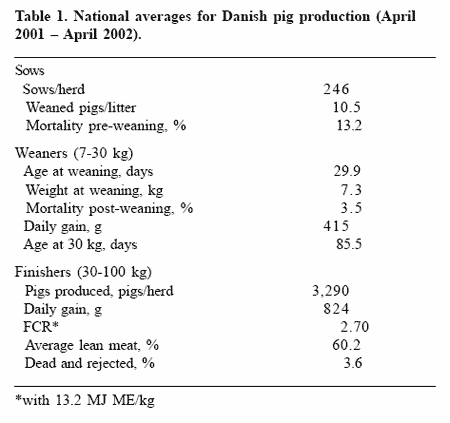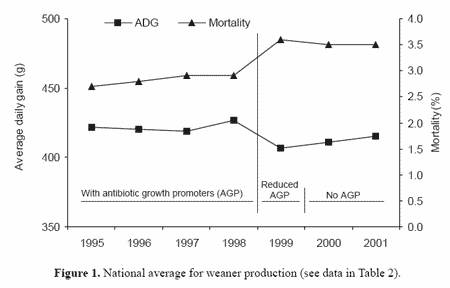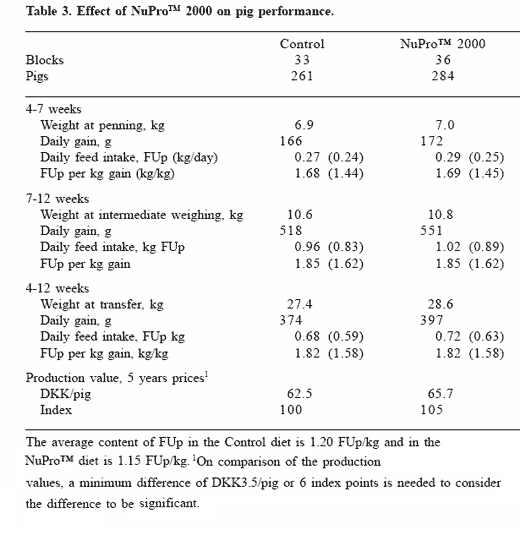Weaning pigs without antibiotic growth promoters
Weaning pigs without antibiotic growth promoters: strategies to improve health and performance
Introduction: Danish pig production
Annually, 13,500 pig producers produce 22.5 million pigs in Denmark (Table 1). This equates to 1.8 million tonnes of pig meat; and of this approximately 1.6 million pigs are used for live export. More than 95% of all pigs in Denmark are slaughtered at the two farmer-owned co-operative slaughterhouses (Danish Crown and Tican). Eighty to 85% of the pig meat is exported primarily to the EU, Japan and the US. The remaining 15-20% is sold in the domestic market – making a total value of $3.9 billion. 
Danish pig producers delivering pigs for slaughter to the co-operative slaughterhouses pay a levy of approximately DKK14 ($2.0) per pig. The money is administered by the Danish Meat and Bacon Council, and is spent on research and development (The National Committee for Pig Production, NCPP), marketing, information, etc.
Removal of AGPs from pig feeds: the chain of events in Denmark
On January 1, 2000, antibiotic growth promoters (AGPs) were removed from animal production in Denmark. The reason for removing the antibiotic growth promoters from the feed was to minimize the consumption of antibiotics.
FINISHERS
NCPP collected experiences from 62 Danish finisher herds in the period after they stopped using APGs. The majority (63%) of the herds did not experience problems such as reduced daily gain or increased frequency of treatments for diarrhoea when AGPs were removed from the feed. Some herds (26%) experienced a temporary decrease in the daily gain, while 11% experienced permanent problems attributed to the removal of AGPs. Thus the removal of AGPs from the feed has been fairly unproblematic in the herds participating in this study. Statements of the national averages for production efficiency confirm the results of the study.
WEANERS
The use of APGs for weaners ceased completely as of January 1, 2000. However, many pigs (approximately 50%) had been fed diets without APGs beginning in mid-1999. Table 2 presents the developments in daily gain and mortality in the weaning period (7-30 kg). The table illustrates the decrease in daily gain (20 g) and a corresponding increase in pig age at 30 kg that occurred from 1998 to 1999. In 2000 and 2001 the daily weight gain increased a little compared with the previous years. Post-weaning mortality also increased (0.7% units) in the 1999 statement compared with 1998, but has stabilized in 2000 and 2001 (Table 2 and Figure 1). Thus, the removal of AGPs from feed for weaners has had significantly negative consequences in the form of reduced gain and higher mortality. The removal of AGPs from weaner feeds has also exacerbated a number of fundamental problems:
1. Increased post-weaning diarrhoea
2. Increased chronic infections (Lawsonia intracellularis)
3. Increased nutritional overload
4. Reduced utilization of nutrients in the feed 
Click here to enlarge Table 2
THE EFFECT ON THE CONSUMPTION OF MEDICINE
Denmark has some of the world’s tightest legislative controls on medicine. This is one of the reasons why Denmark only uses about 1% of the EU consumption of medicine for pigs even though we produce 10% of the pigs in the EU. A change in legislation in 1995 prohibited veterinarians from profiting on sales of medicine.
A number of changes were made in nutrition and management in order to combat the increase in outbreaks of diarrhoea after removing AGPs from the feed. Nevertheless, many herds find it necessary to apply medicine for treatment of diarrhoea in weaners and young stock. While the consumption of AGPs has decreased from 107 tonnes in 1997 to 0 tonnes in 2000, the consumption of antibiotics, primarily macrolides and tetracyclines, for treatment of disease has increased from 56 tonnes in 1997 to 80 tonnes in 2000. Overall, the consumption of antibiotics was halved in four years, but both politicians and consumers focus great attention on the increasing usage of medicine.
OPTIMISING PRODUCTION IN HERDS WITH PROBLEMS
The National Committee on Pig Production has recently performed tests in a number of herds with weaners experiencing severe problems after having stopped using antibiotic growth promoters. The herds all had poor health, a high consumption of medicine, low gain in the weaner period and high mortality. The aim was to examine if it was possible to restore health and production results in the weaner section by optimising the production conditions in general. Improvements in the test group included: improved management procedures, improved hygiene, pen design, composition of the feed, feeding strategy, etc. The measures in the test group were compared with the herd’s normal practice with and without addition to the feed of a growth promoter (avilamycin), but without strategic medication. The results show that the pigs given AGPs in the feed generally have the best productivity – this was the case in four of eight herds. However, the optimised management reduced the number of treatments for diarrhoea (five out of eight herds) even when compared with using a growth promoter in the feed. The optimised management reduced mortality significantly in two herds.
How can we help the small pig at weaning?
MANAGEMENT FACTORS
One of the most significant areas for reducing the negative impact of the removal of AGPs is optimisation of management, including:
- Health-enhancing housing systems with sectioned batch operation. All-in-all-out management and WTF (weaning-to-finish in the same pen) strategies have become more widespread, and Danish tests of these systems show that they may improve both health and productivity.
- Managing pen and batch sizes. Slower growth has resulted in accumulation of weaners in many herds (because of the longer stay in the weaner unit). Overcrowding, increased batch sizes and lack of hospital pens have probably exacerbated the negative impact of AGP removal.
- More focus on the immediate environment in the pen. Experience from Danish herds with problems shows that management, design and maintenance of ventilation systems are often faulty. As a consequence, the pigs are exposed to draught, cold and humidity resulting in poorer health.
- More focus on weight at weaning. A Danish test showed that improving management in the farrowing unit could help increase weight at weaning.
NUTRITIONAL CHANGES
The composition of the feed, its physical form and the feeding strategy may also affect gastrointestinal health and productivity. In Denmark, focus is on restricted feeding, use of protective diets and nonantibiotic additives.
RESTRICTIVE FEEDING
A Danish study of restricted feeding (75% of the feed allocated to control pigs) for the first 14 days post-weaning showed that pig health was significantly improved compared with ad libitum feeding. Mortality was also reduced in one of three herds tested. The production results for the entire test period (4-5 weeks) were reduced during restrictive feeding in one of three herds.
Restricted feeding in various forms is fairly widespread in Danish weaner herds. International literature states that feed intake must be stimulated in the first days post-weaning (days 0-3) in order to minimize injuries to the epithelial surface of the intestine that would reduce digestive capacity. In the following period (days 4-8) feed intake must be reduced until the intestinal structure is reestablished.
PROTECTIVE DIETS
Protective diets are typically characterised by low protein content, large amounts of animal protein (fish meal, whey powder, skimmed milk powder), a high proportion of barley and the addition of organic acids. Danish studies with various types of protective diets have shown that those with such a composition may reduce the incidence of diarrhoea. Protective diets with reduced energy content, however, had no effect on health, and the production results were significantly reduced.
NON-ANTIBIOTIC ADDITIVES
The National Committee for Pig Production has tested more than 100 commercial products (additives) for weaners and finishers in the last five years. These tests were carried out in herds without significant disease problems. For weaners, in general, the organic acids are the best alternatives to AGPs. The best group of acid products on average improved production results to the same extent as AGPs. The positive effects of organic acids are primarily due to increased daily weight gain and improved feed utilisation. We have furthermore found that organic acids reduce the pH in the stomach, improve the growth of lactic bacteria and reduce growth of coliform bacteria.
NuproTM 2000: an alternative protein source for weaners
One of the additives tested recently was NuproTM 2000 from Alltech, a protein source based on yeast cell contents. The product is rich in protein and can therefore be used as an alternative to easily digestible protein sources such as fish meal, milk protein, etc. NuproTM 2000 furthermore contains nucleotides, which are expected to aid disease resistance by enhancing the animal’s ability to fight viruses and bacteria.
The aim of testing NuproTM 2000 for weaners was to evaluate economic impact on production when NuproTM 2000 is used as an alternative to traditional protein sources. The response was evaluated primarily in terms of production value (gross margin), which was calculated based on daily gain and feed conversion. Secondarily, the number of disease treatments was measured.
Methods
NuproTM 2000 was tested in diets fed weaners in the period from about 14 days pre-weaning until 12 weeks of age. The test was carried out in one herd and comprised a total of 545 pigs divided into 33 replicates per group. The test was carried out at Grønhøj experimental station. All pens were equipped with slatted floors in two thirds of the pen.
Each pen had one nipple drinker. In the farrowing unit, the sows were divided into two groups and the piglets were given diet 1 from about 14 days of age until weaning. The actual test period was from weaning at about 4 weeks through 12 weeks of age.
The control diet consisted of Diet 1, which was fed from age 2 to 4 weeks in the farrowing unit and subsequently in the weaner unit from 4 to 7 weeks of age. A second diet was offered from 7 to 12 weeks of age. The test group was managed similarly, however the diets included 2.5% NuproTM 2000.
The diets were formulated with 5% extra lysine, methionine, cystine, threonine and tryptophan to ensure against variations in ingredient crude protein content. The rest of the nutrient profile met standards established in 2000 by the National Committee for Pig Production. Antibiotics were not added to either of the diets. NuproTM 2000, which is a dry product, was added directly into the mixer together with vitamins and minerals. In diet 1 for the test group, NuproTM 2000 replaced 2% fishmeal and ~1% whey powder. In diet 2, NuproTM 2000 replaced ~1.6% fish meal in the diet. NuproTM 2000 was included in the formulation based on analytical values obtained from Alltech. Synthetic amino acids were added to both feed diets in order to comply with the standards.
Treatments of individual pigs for diarrhoea were according to the guidelines of the veterinarian. If more than 50% of the pigs in a pen suffered from diarrhoea, collective treatments were administered by giving the pigs electrolytes in water and antibiotics either through water or feed.
The production value was analysed as primary parameter. Disease treatments were analysed as secondary parameter. Data were subjected to an analysis of variance using the GLM procedures of SAS with the following model: block, housing unit and group. Significant differences are stated at 5%. The results are presented as LS means for each group; and as the pigs were divided in the farrowing unit, adjustment was not made to the same weight on penning in the calculation. Furthermore, data were tested for outliers to ensure that no block deviated significantly from the others.
Results
Analytical and calculated nutrient contents differed to some extent. The methionine and methionine + cystine contents were lower than calculated in all diets, but none exceeded the latitude of the feedstuff legislation. There was no difference between the two groups in nutritional content of the diets that could have affected the results of the study.
There were no differences in the number of days with diarrhoea treatments between the control group and the test group. The pigs in the test group were treated for disease for 2.4 days on average. Of this time, 2.0 days constituted treatments for diarrhoea. The majority of the treatments were carried out in the period before intermediate weighing. Significantly more pigs died in the control group (4.8%, corresponding to 13 pigs) compared with the group with 2.5% NuproTM 2000 (1.4%, corresponding to four pigs). The causes of death were not investigated in this trial.
Production results are stated for the ages of 4-7 weeks, 7-12 weeks, and the entire test period (4-12 weeks) (Table 3). The production value was calculated based on daily gain and feed efficiency. The prices for feed and values for pigs were averages of prices from 1996 to 2000. Overall, the test showed that the production value tended (P=0.08) to improve when 2.5% NuproTM 2000 was added to the feed. This was primarily due to higher daily gain over the entire growth period. Effects of NuproTM 2000 inclusion on the incidence of diarrhoea could not be established. There were significantly more dead pigs in the control group compared with the group that was given NuPro™ 2000. The difference between the groups was 3.4 percentage points, corresponding to nine pigs.

Conclusion
Overall, we can say that the removal of antibiotic growth promoters from pig feeds in Denmark has had significant consequences for weaner production in the form of increased mortality and reduced rates of gain. The negative effect on productivity has stopped. Average daily weight gain has started to increase again and the mortality has stabilized. This shows that most of the Danish pig farmers have learned to live without antibiotic growth promoters in the diets. Experiences from weaner herds with problems at weaning illustrated that the existing knowledge of fundamental management aspects, feeding, etc. is not implemented optimally in practice. Tests in herds with problems at weaning show that optimisation of the production conditions can improve health, even when compared with use of a growth promoter. However, it is harder to maintain the same level of productivity. There appear to be some products that improve productivity at weaning. However it should be noted that neither any single product nor any single small change is ever enough to increase productivity in a herd with significant problems.





